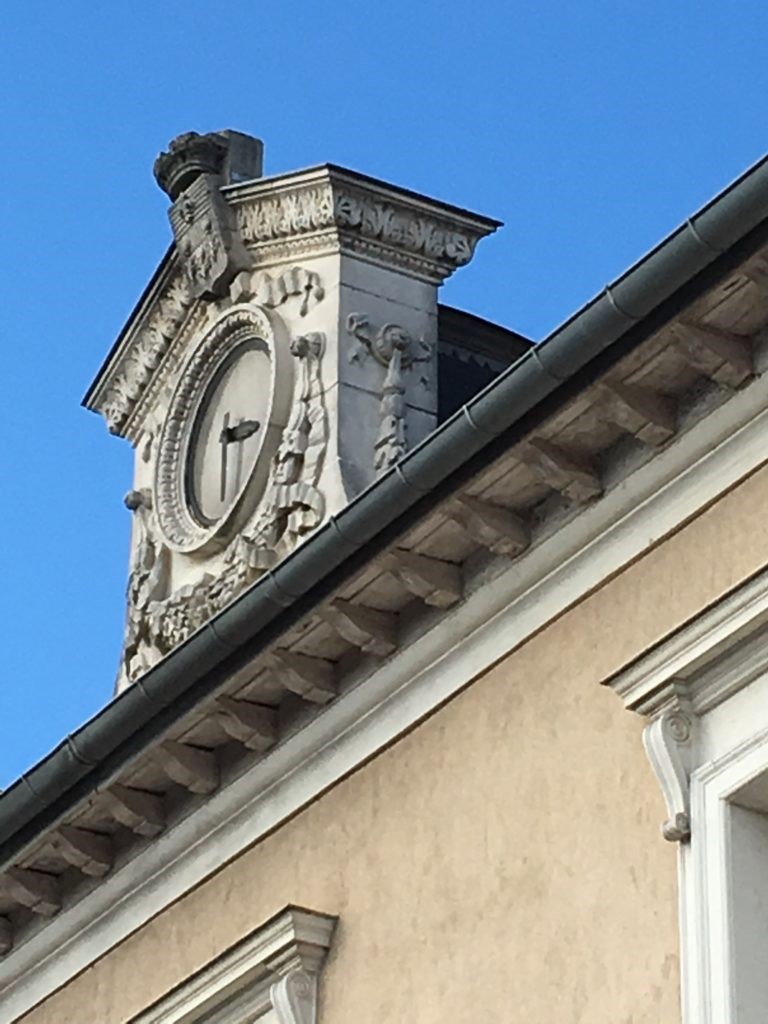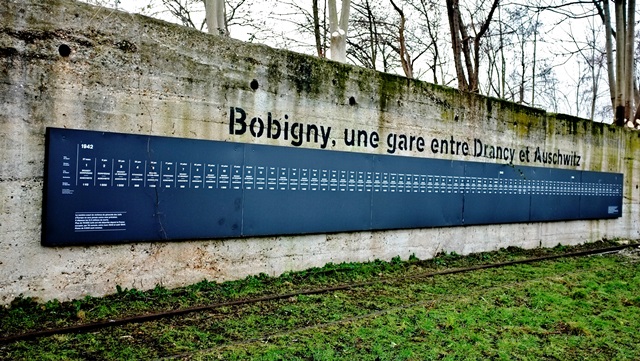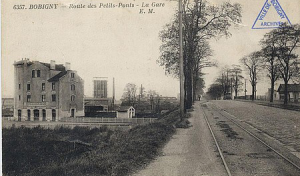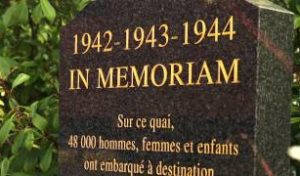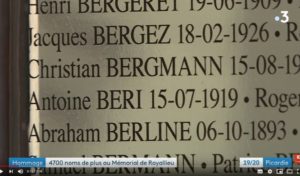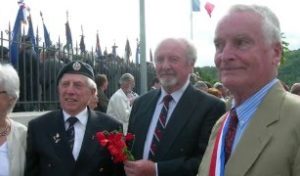Partnering with memorial sites
We have helped set up Second World War memorials across France since 1992 and have lent our support to renovation works and educational programs at numerous other sites.
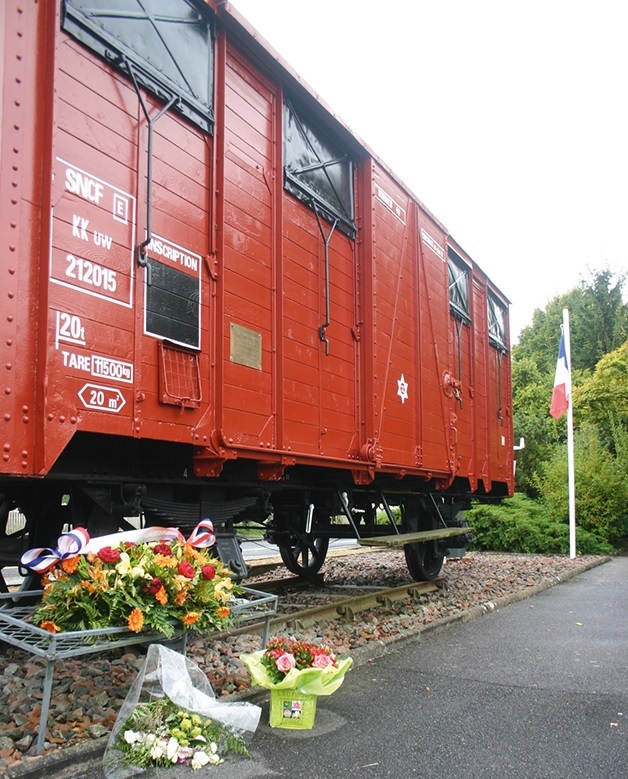
Drancy transit camp
Between 1941 and 1944, the Cité de la Muette—an apartment complex in Drancy, a northern suburb of Paris—served first as an internment camp and then as a transit camp for Jews awaiting deportation. Of the 75,721 Jews deported from France, approximately 63,000 were held at Drancy before being loaded onto trains at Le Bourget-Drancy station and, from July 1943, at Bobigny station. Most were bound for Auschwitz. Only 5.2% of the deportees lived to see the end of the war.
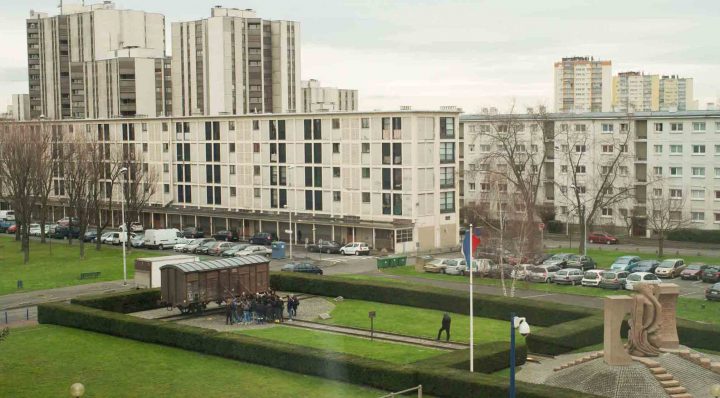
SNCF’s partnership with the site dates back to 1988 when we donated a boxcar to the local town council as part of a remembrance initiative. The boxcar was set up at the entrance to the complex as a memorial.
In 2005, we sponsored a project to refurbish the escape tunnel from the camp. Detainees started digging the tunnel in September 1943. By the time the Nazis discovered it two months later, it was 38.5 meters long, 1.3 meters high, and around 0.8 meters wide. The prisoners were just three meters short of finishing the passage when they were caught. The Nazis arrested 14 of them, who were tortured and then deported on November 20, 1943. Twelve of the 14 jumped from the moving train and joined the French Resistance.
We also provided funding for Drancy, Last Stop Before the Abyss, a 2002 documentary directed by Cécile Clairval-Milhaud.
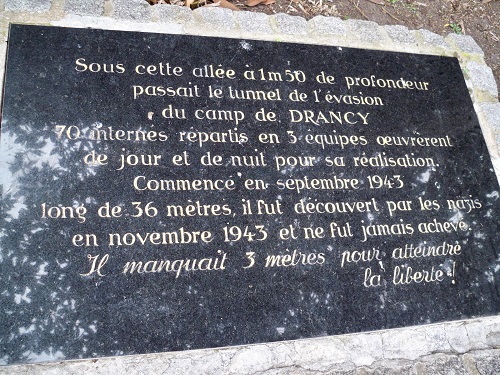
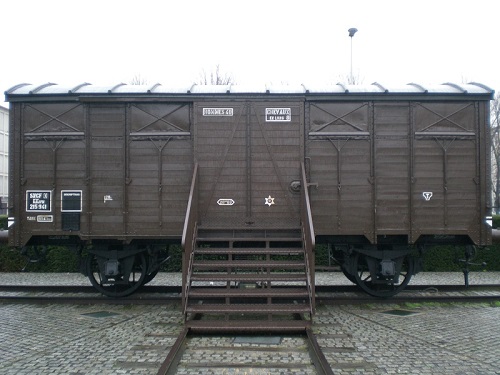
Learn more about the Shoah Memorial in Drancy
Bobigny deportation station
In summer 1943, the freight yards in Bobigny, a town north-east of Paris, replaced Le Bourget-Drancy station as a major deportation site for French Jews. In the 13 months between July 1943 and August 1944, convoys carried approximately 22,500 Jewish men, women, and children to Nazi concentration camps from the Drancy transit camp some two kilometers away.
In the early 2000s, we launched a project to refurbish the site—to preserve the 3.5 hectares of freight yards in their original state and, in doing so, to honor the memory of the thousands of French Jews transported from there to their deaths.
As a result, the Bobigny freight yards remain almost exactly as they were at the end of the Second World War: the tracks, sleepers, ballast, and cobblestones are frozen in time, serving as a powerful reminder of the past. The refurbishment project entered full swing in 2004, and the entire site—buildings, rails, and land included—was listed as a Historic Monument the following year. In December 2008, we publicly announced our decision to hand over the station and freight yards to the town of Bobigny.
Guillaume Pepy delivers a landmark speech
On January 25, 2011, Bobigny mayor Catherine Peyge and SNCF Chairman Guillaume Pepy signed a partnership agreement pledging to convert the abandoned freight yards in Bobigny into a memorial.
At the signing ceremony, Mr. Pepy made a formal speech before an audience of deportees and prominent members of France’s Jewish community, in which he spoke about SNCF’s role in the deportation and expressed the company’s “deep sorrow and regret for the consequences of the acts of the SNCF of that era.”
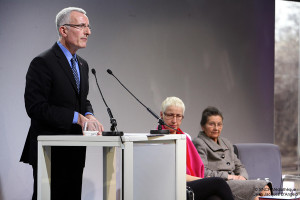
At the time, SNCF was—forced, requisitioned—a cog in the Nazi extermination machine. […] Our company drove these trains to the border. It was forced to do it, but it did it. […]
Here, in these surroundings, which are henceforth engraved in the memory of each one of us, I want to express SNCF’s deep sorrow and regret for the consequences of the acts of the SNCF of that era. In its name, I am humbled before the victims, the survivors, and the children of the deportees, and before the suffering which lives on.
Learn more about the Bobigny freight yards and how we are honoring the past:
In January 2012, the site hosted Bobigny, from Drancy to Auschwitz, a temporary exhibition created with SNCF’s support. It was inaugurated by Bobigny mayor Catherine Peyge and SNCF Chairman Guillaume Pepy on January 27—International Holocaust Remembrance Day, which marks the liberation of Auschwitz concentration camp on January 27, 1945.
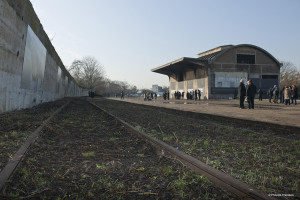
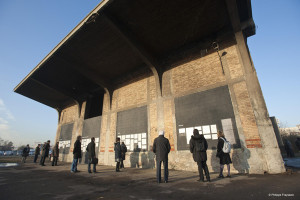
In 2010, the local council produced a short film under the same name, telling the story of the Bobigny deportations through conversations with people who lived through the events of the time. The film was screened as part of the exhibition. Watch the film (in French) here.
Remembering the past and teaching its lessons
The Bobigny freight yards have become a historic, iconic site and a place to remember those who were deported and lost their lives. Visitors have a rare and moving opportunity to stand in the same place where thousands of deportees awaited the convoys that would take them away forever.
The site also provides an excellent learning opportunity, bringing home the tragedies of war to one and all—and ensuring that future generations never forget or downplay the crimes against humanity perpetrated by the Nazis. By teaching visitors about the circumstances that led to the Holocaust, the memorial champions the values of democracy and serves as a bulwark against present-day intolerance and extremism.
Converting the freight shed into a visitor center
As part of our 2011 partnership agreement with Bobigny Town Council, we teamed up with the Greater Paris Regional Council to convert the former freight shed at Bobigny station into a visitor center. Although this warehouse played no role in Second World War deportations, it is immediately adjacent to the tracks where the boxcars used to transport deportees to concentration camps once stood. Since 2012, commemorative displays—including a list of the convoys that departed from Bobigny—have been posted on the shed’s outer walls.
The restored shed was inaugurated on January 27, 2015—70 years to the day after the liberation of Auschwitz. The ceremony was attended by Bobigny mayor Stéphane de Paoli, alongside representatives from SNCF and the Auschwitz Memory Fund Association (AFMA).
“We have a duty to remember. But we also have a duty to educate. To never relent in passing on the lessons of the Holocaust. And to teach everyone what it means to be human. No one has the right to take another person’s life. So, in these difficult times for our country, we must be steadfast in imparting this fundamental idea to future generations. […] I hope that our message will be one of peace. Because the things that set us apart, Muslims, Jews, Christians and non-believers alike, count for nothing if we cannot also unite around the things that bring us together—around the common values that we share.”
Speech given Stéphane de Paoli, Mayor of Bobigny, at the inauguration of the restored freight shed at Bobigny deportation station, January 27, 2015.
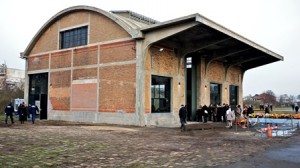
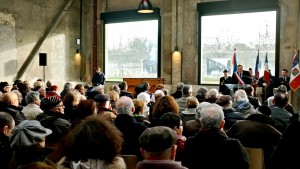
Re-landscaping the site
Once ongoing landscaping and redevelopment work is completed, the Bobigny freight yards will blend seamlessly into the surrounding urban environment. The site will serve as a fully-fledged memorial to the thousands of Jews deported from France during the Second World War.
Learn more: Bobigny deportation station website
How to visit the site: http://garedeportation.bobigny.fr/56/visiter-la-gare.htm (in French)
Schools and other groups: To schedule a group visit, call +33 (0)1 48 96 25 88 or +33 (0)1 48 96 25 86.
Individuals: To arrange an individual visit, contact the local tourist office at 140 Avenue Jean-Lolive, 93695, Pantin, call +33 (0)1 48 15 98 98, or visit exploreparis.com.
Getting there:
Address: Ancienne gare de deportation, 69–151 Avenue Henri Barbusse, 93000, Bobigny.
By metro: Take metro line 5 to Pablo Picasso, then take tram T1 towards Saint-Denis and get off at the Escadrille Normandie Niemen stop.
By bus: Take bus 151 from Porte de Pantin towards Bondy Jouhaux-Blum and get off at the Gare (Grande Ceinture) stop.
By car: Take the A86 motorway and follow the signs for Drancy-Bobigny.
More information about visiting the Bobigny site can be found at: http://garedeportation.bobigny.fr/56/visiter-la-gare.htm (in French)
Renovation of the Shoah Memorial
- Our association with the Shoah Memorial stretches back almost two decades.
- It all started in 2002 when SNCF’s Board of Directors agreed to support the renovation of some of the Memorial’s buildings—including a new Wall of Names bearing the full names and dates of birth of the tens of thousands of Jews deported from France by the Nazis.
- In 2010, we signed a four-year agreement to become the “principal partner company of the Shoah Memorial”, providing backing for education programs as part of our broader initiative to teach the lessons of the Holocaust to future generations.
- In December 2013, we presented scanned copies of our Second World War archives to the Memorial, as well as to Yad Vashem in Jerusalem and the United States Holocaust Memorial Museum (USHMM) in Washington D.C.
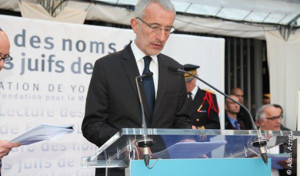
Learn more on the Shoah Memorial website
Camp des Milles
Camp des Milles opened in September 1939 at a tile factory between Aix-en-Provence and Marseille. The camp operated until 1942, serving as a way station for more than 10,000 prisoners from 38 countries—including many from Germany. Most had fled Nazi oppression and persecution in the hope of finding a safe haven in France. The prisoners included a number of artists and intellectuals such as Max Ernst, Hans Bellmer, and Lion Feuchtwanger, all of whom would later escape to the United States with the help of Varian Fry. They developed an active cultural life and a spirit of resistance in the camp by creating hundreds of works, some of which are still visible at the site. In August and September 1942, the Vichy government organized the deportation of over 2,000 Jewish men, women, and children to transit camps at Drancy and Rivesaltes and then on to Auschwitz.
In 1992, we set up a boxcar memorial at Camp des Milles. The camp opened as a fully-fledged memorial and a museum of history and remembrance in 2012—and we have been supporting on-site educational activities ever since. Designed primarily for students, it aims to give future generations an understanding of the past and to help them stand up to racism, anti-Semitism, and all forms of radicalism.
Camp des Milles also houses 1942–1944: 11,400 French Jewish children deported to Auschwitz, a permanent exhibition designed by Serge Klarsfeld and the Association of Sons and Daughters of Jewish Deportees from France. The collection went on tour at stations between 2002 and 2004 with SNCF’s support.
Work on turning Camp des Milles into a memorial started on December 16, 1990 with the opening of the “Path of the Deported,” which follows the exact route Jewish men, women, and children took to join the convoys. On October 9, 1991, the coordinating committee became the Les Milles Wagon of Remembrance Association, an umbrella body representing the Jewish community, the Friends of Auschwitz Deportees, and local deportees, detainees, and Resistance fighters’ organizations. Then, in 1992, SNCF gave the Friends of Auschwitz Deportees a contemporary boxcar, which was converted into a deportation memorial. With support from the local government and the local education authority, an information and education campaign was organized to coincide with its opening on November 9 that same year. Learn more about the history of the project on the Camp des Milles website (in French)
In 2011, a Second Word War-era boxcar identical to those used in the deportations was found at marshaling yards in Miramas, in the Provence-Alpes-Côte d’Azur (PACA) region of southern France. We restored the wagon to its original condition at our Nîmes Technicentre. The work was funded by SNCF, the PACA Regional Council, and the local rail workers’ works council, which teamed up with the Camp des Milles Foundation to launch a public fund-raising appeal. The restored boxcar was unveiled on September 21, 2015, replacing the one that had stood at the site since 1992. The inauguration ceremony was covered in this article (in French) in the local press.
Learn more about Camp des Milles (in French) and see photos of the site.
Compiègne station
In 2007, we helped install a boxcar memorial at the train station in Margny-lès-Compiègne, northern France, from where nearly 48,000 people were deported between March 1942 and August 1944. The first two convoys of Jewish deportees left Compiègne station for Auschwitz on March 27 and June 5, 1942. On July 6 that same year, the first convoy of political deportees—mostly communists—pulled out of the station, again bound for Auschwitz. The Nazis carried out mass deportations of political prisoners and Resistance members from January 1943 onwards. Some were transported in small groups to German prisons. In contrast, others went in 28 large convoys—each carrying one to two thousand people—to concentration camps at Auschwitz, Buchenwald, Dachau, Mauthausen, Natzweiler-Struthof, Neuengamme, Ravensbrück (exclusively for women), and Sachsenhausen, as well as to smaller satellite camps. Before being deported, most were held at Royallieu-Compiègne internment camp about four kilometers from the station.
According to research by the Fondation pour la Mémoire de la Déportation, around 88,000 people were deported because they engaged in Resistance efforts, because they spoke out against the occupying forces, or because they held views the Nazis and their collaborators considered dangerous. The figure also included hostages, common criminals, and people rounded up by the authorities. Over 40% of these deportees are estimated to have died.
The Boxcar Deportation Memorial, a listed Historic Monument, was officially inaugurated in March 2013. It stands alongside a second wagon at a platform made available by SNCF. Both are open to the public and popular with school groups, who come to see videos and hear clips of former deportees talking about their experiences.
Learn more on the Margny-lès-Compiègne Boxcar Deportation Memorial website (in French)
Royallieu-Compiègne internment camp memorial
Poet Robert Desnos was held at Royallieu-Compiègne internment camp in northern France. In a letter penned to his wife, Youki, after his arrest, he wrote: “I managed to miss the last departure, and I really hope to miss the next. I am with very good and nice people: communists, Gaullists, royalists, parish priests, nobles, and peasants. It is an extraordinary melting pot.” Desnos was deported on April 27, 1944 and died at Terezín (Theresienstadt), a concentration camp in occupied Czechoslovakia, on June 8, 1945.
Royallieu-Compiègne, built in 1913, was a former French army barracks. From 1941, it was used by the Wehrmacht first as a “permanent concentration camp for active enemy elements” and later as a “German police detention camp.” The camp, a central plank of the German occupation policy, housed close to 45,000 people—a diverse population of inmates from many different countries and arrested for various reasons. Most were political prisoners and Resistance fighters brought to Royallieu-Compiègne from prisons across France pending deportation to Nazi concentration camps. They were joined by civilian internees—including Russians and Americans—and Jews.
An Internment and Deportation Memorial opened at the site in February 2008 to honor the memory of the detainees and to shed light on the camp’s complex past. A specially designed trail winds through two preserved buildings from the former barracks; it also takes in the chapel, the escape tunnel, and the wall of names. The immersive experience, which includes educational resources, a research center, and survivors’ testimonies, takes visitors—members of the public and historians alike—back in time, revealing what life was like for those held at the camp.
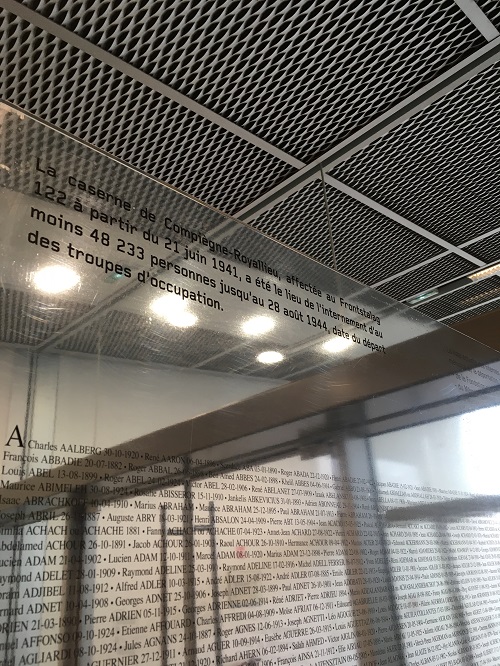
An updated wall of names was unveiled on February 14, 2020, paying homage to the 48,233 people held at the camp during the Second World War. The expanded list includes an additional 4,700 names to reach this new total. SNCF supported the background research and provided funding for the refurbishment of the wall.
Learn more on the Royallieu-Compiègne Internment and Deportation Memorial website (in French)
Getting there:
Address: 2 bis Avenue des Martyrs de la Liberté, 60200, Compiègne
By bus: Take bus 5 and get off at the Saint-Côme–Mémorial stop
Tel.: +33 (0)3 44 96 37 00
Email: accueil@memorial-compiegne.fr
The Last Deportation Convoy Memorial at Nanteuil-Saâcy station
On June 23, 2012, the Last Deportation Convoy Memorial was inaugurated at Nanteuil-Saâcy train station, in northern France, in the presence of representatives of the French State, the organizing committee, the Fédération Nationale des Associations de Déportés et Internés de la Résistance, and SNCF.
The memorial pays homage to the 2,400 members of the Resistance detained in Fresnes and With support from the local government and the local education authority, an information and education campaign was organized to coincide with its opening on November 9 that same year. prisons who were deported by the SS on August 15, 1944. The train left the freight yards at Pantin station on the morning of August 16 but stopped in Nanteuil because the Royal Air Force had destroyed the bridge over the Marne river. Flanked by their SS guards, the prisoners walked several kilometers to reach a train at Saâcy train station, on the other side of the Marne.
One week later, the men reached Buchenwald concentration camp, and the women arrived at Ravensbrück. Most of the men were then transferred to the hell of the Mittelbau-Dora, Ellrich, and Nordhausen camps.
The Nazis also deported 158 Allied aviators whose planes had been shot down in France. After a detention period in Buchenwald, they were transferred to a POW camp.
SNCF donated a boxcar for the memorial. It was renovated at our maintenance facility in Béziers, southern France, then transported to Nanteuil-Saâcy station by SNCF employees.
Le Chambon-sur-Lignon
During the Second World War, thousands of people fleeing persecution—mostly Jews—found refuge and support in Le Chambon-sur-Lignon, a town of some 3,000 inhabitants in south-central France, and in communities on the surrounding plateau. Unarmed local residents refused to bow to the will of the Vichy government, saving many lives in the process. The area came to symbolize the grassroots Resistance movement for its people’s incredible show of humanity.
In 1990, the State of Israel recognized all of the inhabitants of Le Chambon-sur-Lignon and the surrounding area as “Righteous Among the Nations.” A small garden and plaque on the grounds of the Yad Vashem Memorial in Jerusalem were dedicated to the people of the town. They are also honored on the Wall of the Righteous at the Shoah Memorial in Paris and at the United States Holocaust Memorial Museum in Washington D.C.
A memorial opened in Le Chambon-sur-Lignon on June 5, 2013 as a way to keep alive the memory of the “Righteous” and those who supported the Resistance during the Second World War. The site was developed under the patronage of French President François Hollande and the sponsorship of deportee Simone Veil, a former French cabinet minister and ex-President of the European Parliament, who at the time was Honorary President of the Foundation for the Memory of the Shoah.
SNCF was a project partner and helped finance building renovation in preparation for the memorial’s permanent exhibition.
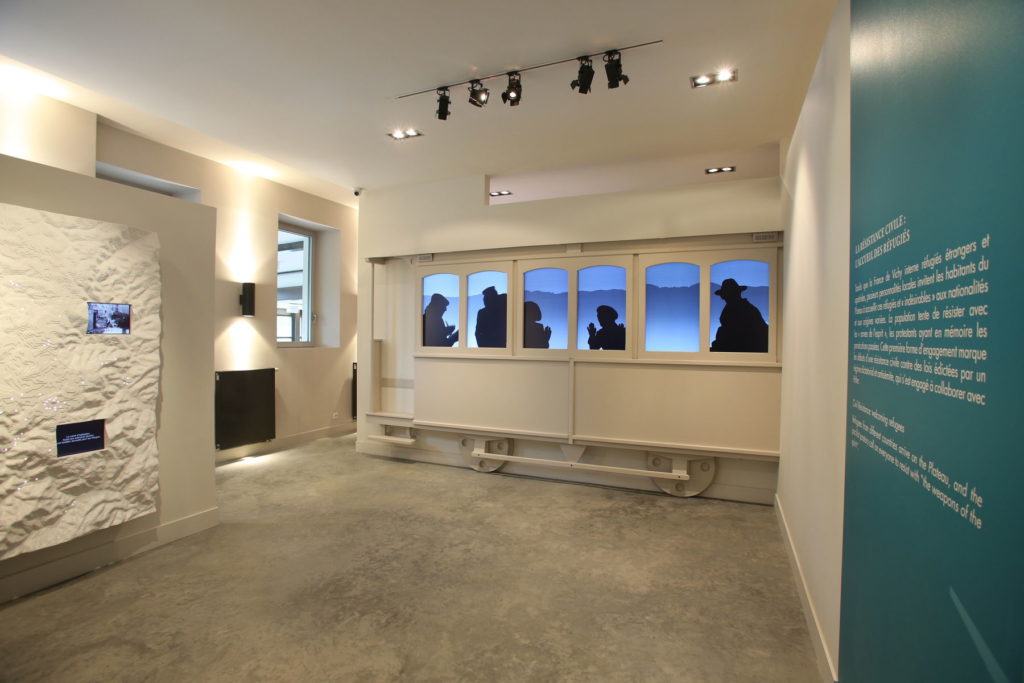
Learn moreon the website of the Le Chambon-sur-Lignon Memorial, take a virtual tour of the site, and read the PDF brochure (in French)
Contact details:
Address: Lieu de Mémoire au Chambon, 23 Route du Mazet, 43400, Le Chambon-sur-Lignon
Tel.: +33 (0)4 71 56 56 65
Email: accueil@memoireduchambon.com
Boxcar memorial at Penne-d’Agenais station
An SNCF-donated boxcar stands outside the train station in Penne-d’Agenais, a village in south-western France. Opened on May 30, 2014, it serves as a memorial to the 1,200 Resistance fighters who, 70 years earlier, were imprisoned at the Eysses penitentiary in the nearby town of Villeneuve-sur-Lot and handed over to the Nazis by the Vichy government. On February 19, 1944, the prisoners rose in mutiny and took over the prison. Twelve of them were executed. The remainder began their long journey to Dachau concentration camp on May 30, 1944. Beside the boxcar—known as the “Wagon of Remembrance”—is a monument bearing the names of the deportees, along with a bust of Jean Ferrat, a French Jewish singer-songwriter who wrote Nuit et Brouillard (Night and Fog) about the Holocaust.
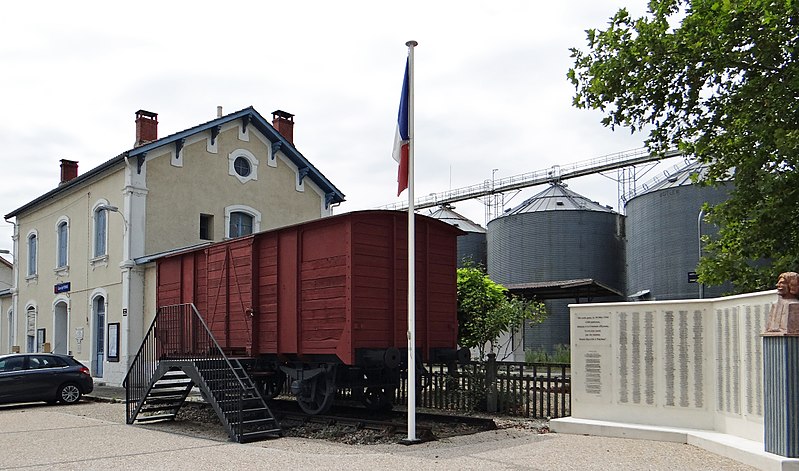
Monument to the Executed in Portes-lès-Valence
The large rail depot in Portes-lès-Valence, south-eastern France, was the scene of sustained sabotage action by members of the Resistance. In retaliation for attacks on locomotives and buildings on July 7 and 8, 1944, the Nazis took 33 inmates from Montluc prison in Lyon, including three from the local area. The prisoners were lined up against a wall of the depot and shot. The Monument to the Executed, erected in their memory, was restored with SNCF’s support.
Learn more about Portes-lès-Valence’s wartime history on the local authority website (in French)
Pithiviers station
In May 2017, SNCF signed a partnership agreement with the Shoah Memorial, which included plans to convert the disused passenger station in Pithiviers near Orléans into a memorial. It opened to the public in 2021. Between 1941 and 1943, some 16,000 Jews were held at camps in Pithiviers and nearby Beaune-la-Rolande, from where they were transported by train to Drancy and other internment camps near Paris. Their number included 4,400 children arrested during the notorious Vel’ d’Hiv’ Roundup, separated from their parents, and taken from Pithiviers to Drancy and onward to Auschwitz. A further 8,100 Jews were deported directly to Auschwitz from the two local camps in eight convoys.
Inside Pithiviers station, a 400 sq m visitor center tells the story of its past—including an exhibition dedicated to Jewish deportees interned at the camps. It also hosts schools and other groups and runs educational activities.
The center is operated by the Shoah Memorial in partnership with Cercil – Vel’ d’Hiv Children’s Memorial Museum, an Orléans-based museum, resource center, and permanent exhibition founded in 2011 to shed light on the role of the Pithiviers and Beaune-la-Rolande internment camps.
Learn more about the Pithiviers and Beaune-la-Rolande internment camps on the Cercil – Vel’ d’Hiv Children’s Memorial Museum website (in French)
